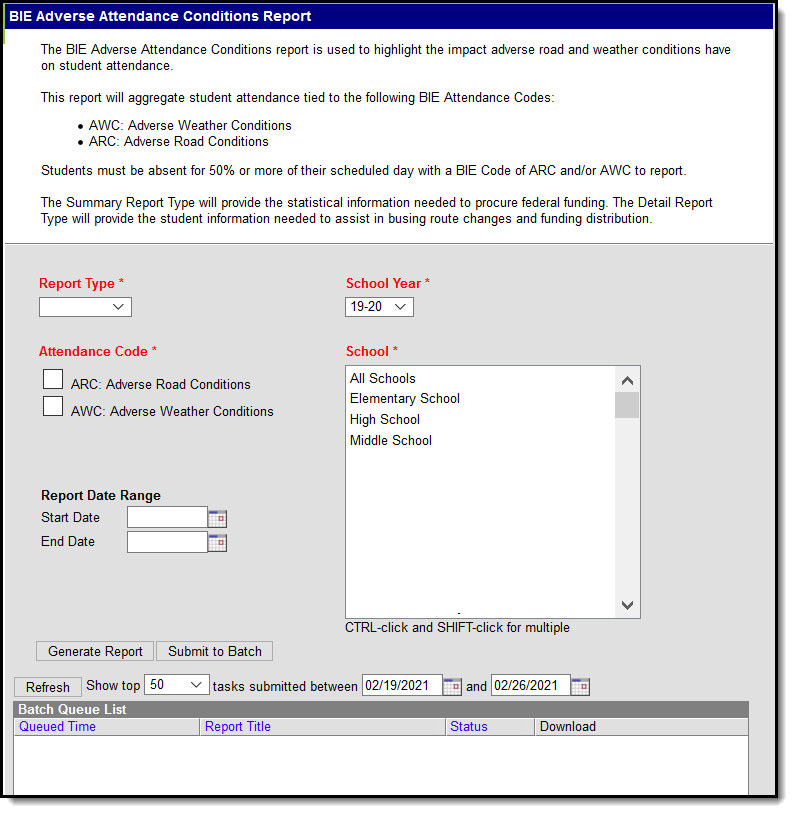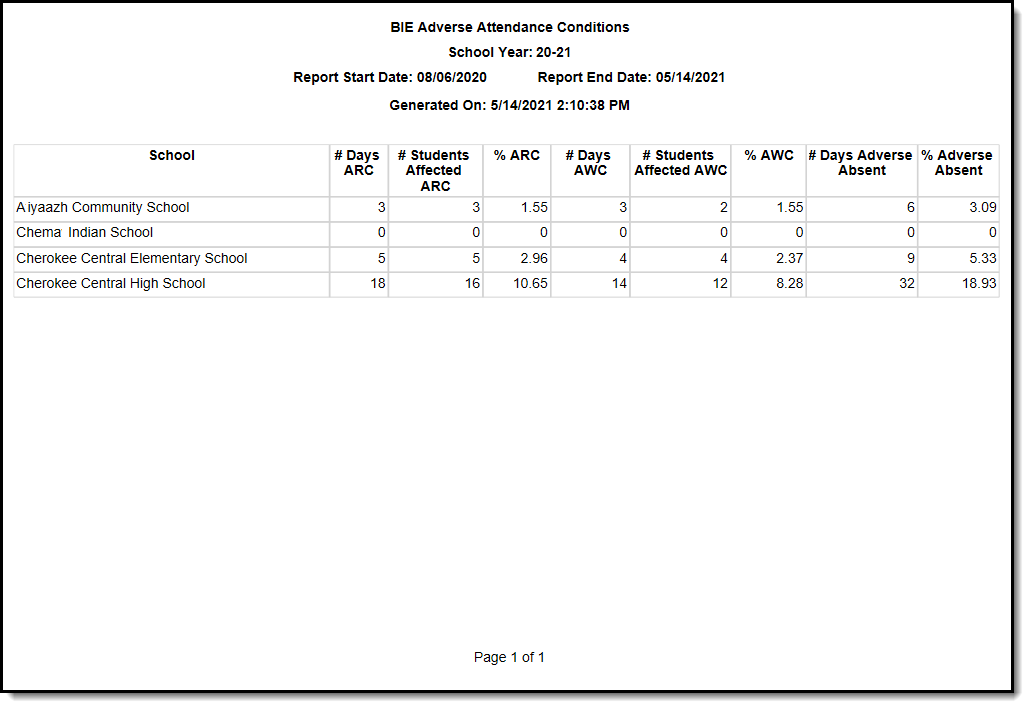Tool Search: Adverse Attendance Conditions
The BIE Adverse Attendance Conditions Report allows states to report the impact adverse weather and road conditions have on student attendance. The information provided by this report may assist with federal funding procurement and distribution, busing changes, and other necessary transportation changes to meet the needs of students affected by adverse weather and road conditions.
This report only considers students absent 50% or more of their scheduled school day with an attendance record tied to the following BIE Attendance Codes:
- AWC: Adverse Weather Conditions
- ARC: Adverse Road Conditions
The BIE Adverse Attendance Conditions Report is only available in BIE State Edition sites.
 BIE Adverse Attendance Conditions Report
BIE Adverse Attendance Conditions Report
Read - Generate and view the BIE Adverse Attendance Conditions Report.
Write - N/A
Add - N/A
Delete - N/A
The Tool Rights article provides more information about Tool Rights and how they function.
Read - Generate and view the BIE Adverse Attendance Conditions Report.
Write - N/A
Add - N/A
Delete - N/A
The Tool Rights article provides more information about Tool Rights and how they function.
Report Logic
This report uses the following logic:
Generate a Report
Before you start, consider the following.
- District-level data is automatically synced to the state weekly. To capture attendance changes between syncs, a state administrator might consider manually running the Resync State Data tool to reflect more up-to-date data in attendance reports and chronic absenteeism calculations.
- On a nightly basis, an automated attendance aggregation job processes the prior day's attendance and recalculates the chronic absenteeism fields for each student. Because this job only looks at changes made to attendance fields the day prior, backdated attendance changes may not be included. To ensure all attendance data (including any backdated changes) are included in the attendance aggregation, recommend to your districts they periodically run the Attendance Aggregation Refresh tool.
If both tools are used to reflect the most up-to-date attendance at the state level, Attendance Aggregation Refresh should be run first followed by the Resync State Data tool.
- Select a Report Type from the two options available.
- Summary: Provides the statistical information needed to procure funding and is used to submit to federal agencies.
- Detail: Provides necessary student demographic information (name, grade, NASIS ID, etc.).
- Summary: Provides the statistical information needed to procure funding and is used to submit to federal agencies.
- Select one or both Attendance Codes.
- Enter a start date and end date for the Report Date Range. If no date is entered, the earliest calendar start date and latest calendar end date (among all selected calendars across all schools) will apply.
- Select a School Year. The year will default to the year identified in the toolbar.
- Select one to multiple schools from the school list under School.
- Select Generate Report or Submit to Batch. Depending on the Report Type selected, the following formats are used:
- Report Type:
- Summary: Report generates in PDF
- Detail: Report generates in CSV
- Report Type:
Summary Report
The Summary Report provides statistical information necessary to procure federal funding. All calculations in the report are representative of student counts and attendance marks identified within the report date range entered.
 BIE Adverse Attendance Conditions Summary Report
BIE Adverse Attendance Conditions Summary Report
Understanding the Summary Report
Only students marked absent with the BIE Attendance codes ARC and/or AWC for 50% or more of their scheduled day are included in report totals. If a student is enrolled in multiple calendars, attendance will be aggregated across all calendars.
| Field | Description | Location |
|---|---|---|
| School | The name of the reporting school and the BIE Group Number |
School & District Settings > Schools > School Information > Name
School & District Settings > Schools > School Information > BIE Group Number
School.name School.ncesSchoolID |
| # Days ARC | The total number of instructional days within the reporting window where one or more students have been affected by adverse road conditions.
If no students are identified then 0 reports. |
Calculated field
|
| # Student Affected ARC | The total number of students affected by adverse road conditions within the report date range.
If no students are identified then 0 reports. |
Calculated field
|
| % ARC | The percentage of instructional days affected by adverse road conditions within the school.
Calculation: # Days ARC / Total Instructional Days |
Calculated field
|
| # Days AWC | The total number of instructional days within the reporting window where one or more students have been affected by adverse weather conditions.
If no students are identified then 0 reports. |
Calculated field
|
| # Student Affected AWC | The total number of students affected by adverse weather conditions within the report date range.
If no students are identified then 0 reports. |
Calculated field
|
| % AWC | The percentage of instructional days affected by adverse weather conditions within the school.
Calculation: # Days AWC / Total Instructional Days |
Calculated field |
| # Days Adverse Absent | The total number of instructional days within the reporting window during which one or more student(s) have been affected by adverse road and weather conditions. | Calculated field |
| % Adverse Absent | The percentage of instructional days affected by adverse road AND weather conditions for the school.
Calculation: #Days Adverse Absent/total Instructional Days |
Calculated field |
Detail Report
The Detail Report provides schools with individual student information so necessary changes can be made for the students whose attendance is affected by adverse weather and road conditions.
 BIE Adverse Attendance Conditions Detail Report
BIE Adverse Attendance Conditions Detail Report
Understanding the Detail Report
The report includes only students marked absent with the BIE Attendance codes ARC and/or AWC for 50% or more of their scheduled day.
| Field | Description | Location |
|---|---|---|
| School | Reports the school name and BIE Group Number | School & District Settings > Schools > School Information > Name
School & District Settings > Schools > School Information > BIE Group Number School.name School.ncesSchoolID |
| NASIS ID | Reports the student of record's NASIS ID. | Census > People > Demographics > NASIS ID
Person.otherID |
| # Days ARC
|
The total number of instructional days within the reporting window during which the student has been affected by adverse road conditions (ARC).
|
Calculated field |
| % ARC | The percentage of the students' rostered days affected by adverse road conditions (ARC).
Calculation: # Days ARC / Total Student Rostered Days |
Calculated field |
| # Days AWC | The total number of instructional days within the reporting window during which the student has been affected by adverse weather conditions (AWC). | Calculated field |
| % AWC | The percentage of the student's rostered days affected by adverse weather conditions (AWC).
Calculation: # Days AWC / Total Student Rostered Days |
Calculated field |
| # Days Adverse Absent | The total number of instructional days within the reporting window during which the student has been affected by adverse road and weather conditions (ARC and AWC). | Calculated field |
| % Adverse Absent | The percentage of instructional days affected by adverse road AND weather conditions (ARC and AWC).
Calculation: #Days Adverse Absent / Total Instructional Days |
Calculated field |
| Last Name | Reports the student of record's Last Name. | Census > People > Identities > Current Identity > Last Name
Identity.lastName |
| First Name | Reports the student of record's First Name. | Census > People > Identities > Current Identity > First Name
Identity.firstName |
| Birth Date | Reports student's Date of Birth. | Census > People > Identities > Current Identity > Birth Date
Identity.birthDate |
| Gender | Reports the student's gender as M (male) or F (female). | Census > People > Identities > Current Identity > Gender
Identity.gender |
| Grade | Reports the BIE Grade Level Code mapped to the grade level the student is enrolled in. | Student Information > General > Enrollments > BIE Grade Level Code GradeLevel.regionalGrade |
